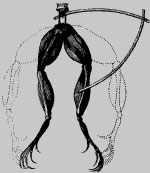
 |
Inlaid into the wooden floor of the basement at the Faraday Museum of the Royal Institution in London is a representation of a plump, green frog. The mosaic serves as a salutary reminder that all of today’s electronic, marvels began with the twitching of a frog’s leg. In Luigi Galvani’s (1737-1798) own words: “I had dissected and prepared a frog in the
usual way and while I was attending to something else I laid it
on a table on which stood an electrical machine at some distance
from its conductor and separated from it by a considerable space.
Now when one of the persons present touched accidentally and lightly
the inner crural nerves of the frog with the point of a scalpel,
all the muscles of the legs seemed to contract again and again as
if they were affected by powerful cramps”. The twitchings were, almost literally, the birth pangs of electrophysiology, and they were soon to show the way to the voltaic pile and current electricity. In a very careful series of experiments in which he fastened “brass hooks in their [the frogs] spinal cord to an iron railing which surround a certain hanging garden of my house” Galvani noticed that the frogs legs went into contractions “not only when the lightning flashed but even at times when sky was quiet and serene”. In the contact between the brass hooks and the iron railing, Galvani came tantalizingly close to the contact theory later advanced by his fellow-countryman, Allesandro Volta. However, Galvani chose to interpret his results in terms of “animal electricity”, which proclaimed that the structure of the muscle retained a “nerveo-electrical fluid” similar to that of an electric eel. Shortly before he died, Galvani
was dismissed from his professorship at the University of Bologna,
because he refused to swear allegiance to Napoleon’s Cisalpine
Republic. As the Dictionary of Scientific Biography poignantly states:
Galvani “died in poverty and sorrow”. |












